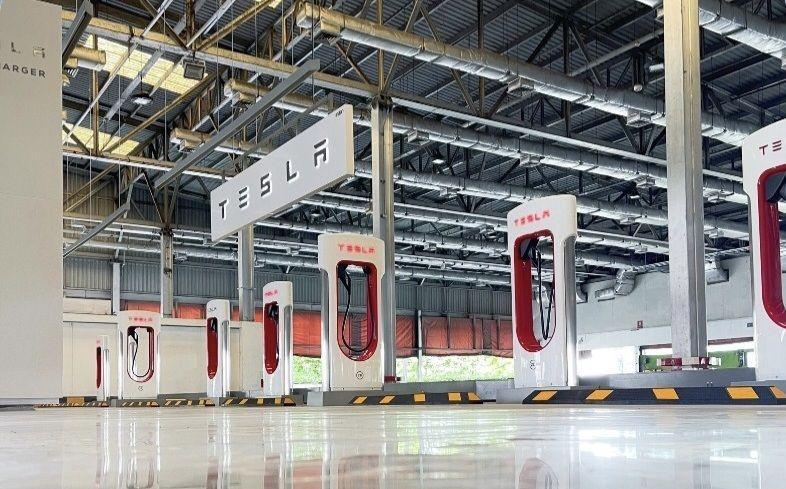The Core Value of Tesla Supercharger
Elon Musk, the CEO of Tesla, has always emphasized the importance of the Supercharger network in providing unparalleled convenience for Tesla owners.
“The goal of the Supercharger network is to enable freedom of travel for Tesla owners at a fraction of the cost of gasoline. Since charging above 80 percent is rarely necessary, stops are typically short and convenient.”
Elon Musk
This vision has been a driving force behind the rapid expansion of Supercharger stations worldwide, aiming to make electric vehicle travel as convenient as possible.
The Reality in Thailand
The reality of the Supercharger network in Thailand is a stark contrast to Musk’s vision. With only 10 Superchargers available in the country as of 2023, and a whopping 70% of them located in Bangkok, the network is far from facilitating seamless road trips across the nation. The lack of Superchargers near highways makes them hard to access, especially for long-distance travelers looking to drive from the North to the South of Thailand.

Adding to the inconvenience, all Superchargers in Thailand are located inside department stores, specifically within the Central Group malls. This means that Tesla owners are required to obtain a parking ticket to access the charging stations, and if their stay exceeds one hour, they are subjected to parking fees. The Superchargers, often located on the upper floors of the parking lots, are not only hard to reach due to internal mall traffic but also contribute to longer waiting times when exiting the mall, especially during peak hours.

For instance, at Central Lardpao, the journey from the mall entrance to the Supercharger on the 6th floor can take up to 8 minutes(busy hours), and the return trip can take up to 20 minutes, not accounting for the additional time spent charging the vehicle. This situation is far from the “short and convenient” stops envisioned by Musk.


Monopoly on Tesla Supercharger in Thailand?
The current state of the Supercharger network in Thailand has raised questions about a potential monopoly, as all 10 stations are located inside Central Group malls. This has led to concerns about whether the Central Group holds an unfair advantage in deciding the locations of Superchargers in Thailand.
The situation at Central Pattaya is a prime example of the challenges posed by the current arrangement of Tesla Superchargers in Thailand. The Supercharger station is situated on the 12th floor of the parking lot, a location that is not only far removed from major highways but also deeply embedded within the internal traffic of the mall. A Tesla owner recounted his experience, describing a journey of approximately 4-5 minutes just to reach the Supercharger. Once there, he spent around 30 minutes charging his car. However, the real challenge arose when it was time to leave.
As he finished charging, he found himself in the midst of the mall’s peak exit traffic, with numerous other vehicles also attempting to leave the parking lot at the same time. This congestion significantly prolonged his departure, turning what should have been a straightforward exit into a 30-minute ordeal. The timing of his charging session coincided with the end of a shopping day for many, resulting in a bottleneck at the exit ramps of the parking lot.
This scenario highlights a critical oversight in the placement of the Supercharger station. By situating it within a busy mall parking lot, Tesla owners are forced to contend with the ebb and flow of mall traffic, turning what is supposed to be a quick and convenient stop into a time-consuming and frustrating experience. The convenience promised by Elon Musk and the Tesla Supercharger network seems to be lost in translation when applied to the context of Thailand, particularly in locations like Central Pattaya.
The Supercharger station at Central Pattaya epitomizes the challenges of Tesla’s current Supercharger network in Thailand, combining impractical location, underutilization, and encroachment by ICE vehicles. Positioned on the 12th floor of the parking lot, the station is not only inconveniently far from major highways but also requires a tedious drive up, making it a less appealing option for Tesla owners.

This has led to a significant decrease in utilization, leaving the Supercharger lot largely abandoned and subsequently claimed by ICE vehicle owners. These drivers justify their occupation of the space by pointing out its consistent vacancy, challenging the efficiency of Tesla’s planning and raising questions about Tesla Thailand’s commitment to enhancing the Supercharger network for its users.

The Future of Tesla Supercharger in Thailand
Despite these challenges, Tesla plans to expand its Supercharger network to other parts of Thailand, including Chiang Mai and Lampang, with new stations planned inside Central Festival malls. This decision raises concerns about whether Tesla is learning from past mistakes or if it is continuing down a path that contradicts Musk’s vision of convenient and accessible EV travel.


“Tesla’s Supercharger network is a game changer for electric vehicles, providing long distance travel that has a level of convenience equivalent to gasoline cars for all practical purposes.”
Elon Musk stated as always highlighted the Supercharger network as a game changer for electric vehicles

The current state of the Supercharger network in Thailand challenges this above statement, as the inconvenient locations, restricted access, and limited operation hours fall short of providing a convenient travel experience.
Tesla Supercharger as a Market Dominator
Since its inception in 2012, the Tesla Supercharger network has been a crucial factor in Tesla’s dominance in the electric vehicle market. Elon Musk has consistently highlighted the convenience of the Supercharger network, making it a significant selling point for Tesla vehicles. In the United States, many customers choose Tesla not just for the car itself, but for the access to the extensive and convenient Supercharger network.
Competitors like Rivian, Porsche with their Taycan model, and Lucid Air with their advanced electric vehicles, have found it challenging to compete with Tesla, primarily due to the lack of a comparable charging network. In Thailand, however, Tesla’s inability to provide a convenient and accessible Supercharger network has resulted in a loss of potential customers, highlighting the need for Tesla to reevaluate and improve their Supercharger strategy in the country.
Conclusion
The current state of Tesla’s Supercharger network in Thailand is a far cry from Elon Musk’s vision of convenient and accessible electric vehicle travel. The concentration of Superchargers in urban areas, coupled with restricted access and limited operation hours, has resulted in a network that falls short of meeting the needs of Tesla owners in Thailand.
As Tesla continues to navigate the Thai market, there is a pressing need for a strategic reevaluation of Supercharger locations and accessibility. Only by aligning the Supercharger network with the core values of convenience and freedom of travel can Tesla hope to fulfill its promise and revolutionize the electric vehicle experience in Thailand.
Top Comment from Thai Tesla User

You’re calling us as whiners, huh?!! Just wait for next month, Central Khon Kaen! Central Udon! Central Phuket! Heh, I don’t care anymore. The whole thing is all about the CEO of Tesla Thailand. Regarding the electricity power issue, I must say it’s all lies. They’re just making excuses. They claimed that the electric company couldn’t provide enough electricity for the Superchargers, which is why they are only opened in Central Group malls. But that’s a complete lie because BYD can open their charging stations anywhere they want in Thailand, and they are not restricted to department stores like you.

